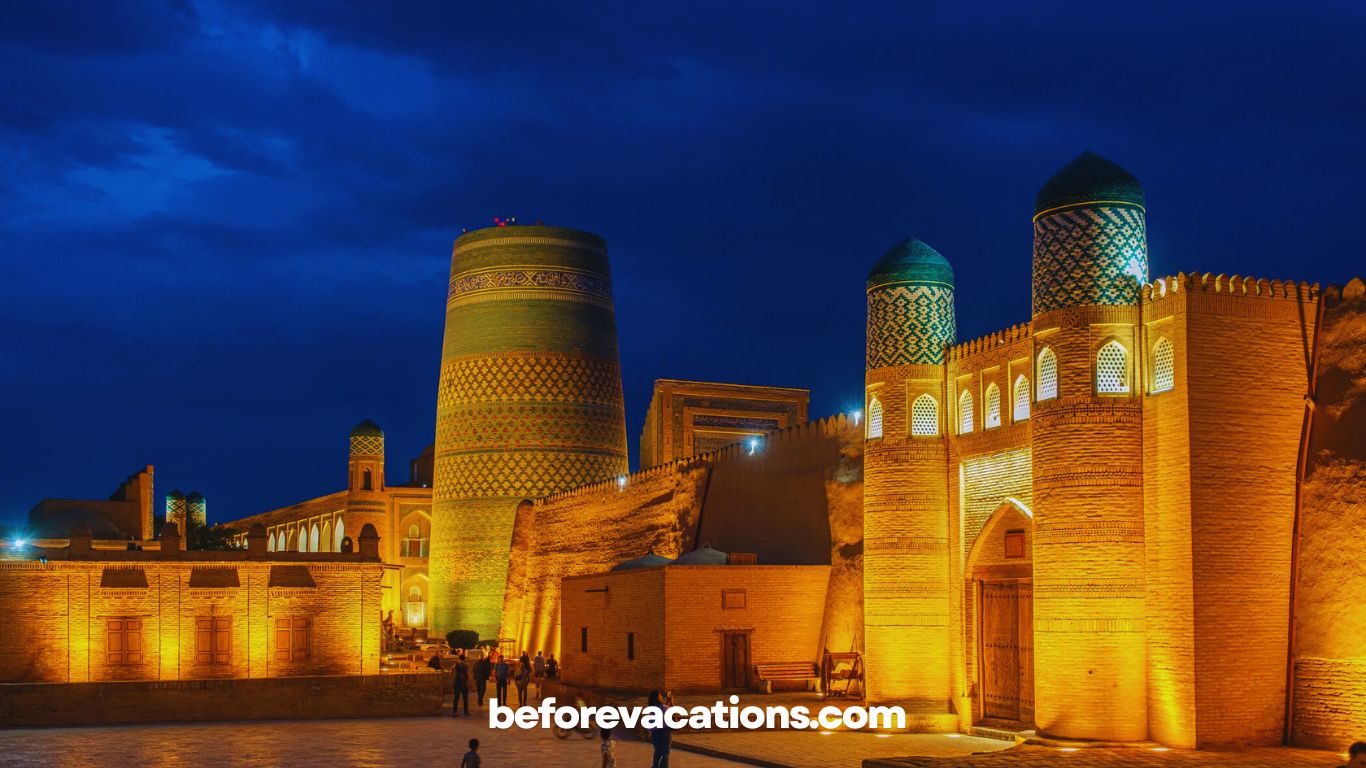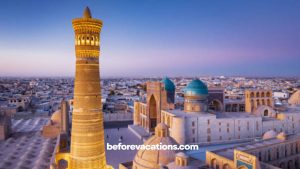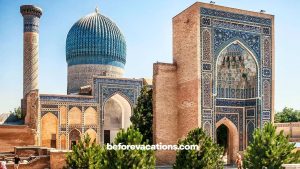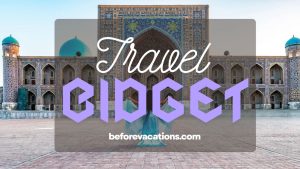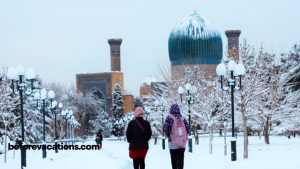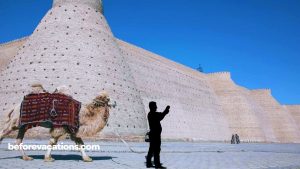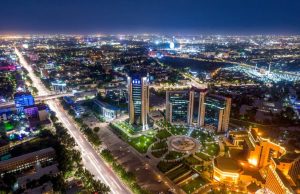Stepping into a Sandcastle: Unlocking the Timeless Beauty of Khiva’s Itchan Kala
Khiva is, for many global travelers, the most visually arresting city on Uzbekistan’s Silk Road. Unlike the sprawling, heavily rebuilt centers of Samarkand and Bukhara, Khiva is a perfectly preserved, compact fortress. It feels like a city-sized, ancient sandcastle. Ten-meter high mud-brick walls surround its inner city, Itchan Kala. Itchan Kala remains a magnificent, car-free labyrinth of mosques, madrasahs, and palaces.
This UNESCO World Heritage site offers an unparalleled opportunity. You can immerse yourself in a place where history has quite literally been frozen in time. The very act of walking its narrow, sun-drenched streets is one of the most rewarding things to do in Khiva Uzbekistan. You find a deep connection here to the merchant-kings and caravan traders. They once relied on this vital oasis before crossing the treacherous Kyzylkum Desert. This comprehensive guide will lead you through Khiva’s iconic landmarks and its hidden cultural depths. This ensures you maximize your adventure in this timeless citadel.
1. Mastering the Minarets: Iconic Towers and Panoramic Views
The sky above Khiva is punctuated by two minarets that define its unique skyline. These towering structures offer history and unparalleled views, easily topping the list of essential things to do in Khiva Uzbekistan.
The Unfinished Masterpiece: Kalta Minor Minaret
Immediately upon entering the West Gate, the distinctive, squat tower of the Kalta Minor Minaret greets visitors. This structure is famously unfinished. It abruptly stops at 29 meters. Its massive base circumference speaks to its original, colossal ambition. Khan Muhammad Amin Khan intended to build it as the tallest minaret in the entire Muslim world. He potentially wanted it to exceed 70 meters. However, construction ceased when the Khan died in 1855. This left behind the striking blue, turquoise, and white tiled cylinder. The cylinder has become Khiva’s most recognizable symbol. Its dense, vibrant tilework beautifully showcases the pinnacle of Khorezmian craftsmanship. This tilework is remarkably preserved from base to top. Tourists can only marvel at its exterior, as the interior is inaccessible, yet its photogenic presence dominates every view from the western side of Itchan Kala.
Climbing the Heights: Islam Khodja Minaret
In contrast to the short, wide Kalta Minor, the Islam Khodja Minaret stands as the tallest structure in all of Khiva, soaring to $56.6 \text{ meters}$. This is a deceptively modern structure, built in the early 20th century by Khiva’s forward-thinking Vizier, Islam Khodja. He built it using traditional techniques, making it blend seamlessly with the centuries-old city around it. Visitors highly recommend the challenging, winding climb to the top.
From the narrow, dark internal staircase, you emerge to a breathtaking 360-degree panorama of the entire walled city. Consequently, travelers see the uniform ochre of the mud-brick walls, the turquoise-tiled domes, and the sprawling desert beyond. Climbing this tower near sunset is one of the most rewarding things to do in Khiva Uzbekistan, offering incredible photography opportunities of the city bathed in golden light.
2. Exploring the Royal Residences: Palaces and Fortresses
Khiva’s political history unfolds dramatically within its ancient fortress walls, where the power of the Khans was once consolidated in heavily guarded compounds. Exploring these sites gives visitors a deep sense of the Khivan Khanate’s opulence and isolation.
The Inner Citadel: Kunya Ark
The Kunya Ark served as the Khivan rulers’ inner fortress and primary residence, functioning as a “city within a city.” This complex included the Khan’s palace, the arsenal, the mint, the stables, a mosque, and a watchtower. The citadel was continuously occupied and rebuilt from the 5th century until the 20th century. Visitors should explore the restored Throne Room, with its striking tiled iwan (entrance portal).
Furthermore, the Kunya Ark Watchtower, accessible through the complex, offers another excellent viewpoint. It provides expansive vistas over the neighboring Mohammed Amin Khan Madrasah and the entire western half of Itchan Kala. Visiting the Ark tells the story of how governance, military might, and domestic life were once held together under one roof.
The Stone House: Tash Khauli Palace
Another essential royal stop is the vast Tash Khauli Palace, meaning “Stone House.” Built in the 1830s by Alla Kuli Khan, this palace features multiple enclosed courtyards that highlight the strict segregation of court life. The palace includes the Harem, the Arzkhana (Reception Court), and the Ishrat Khauli (Winter Court).
The courtyards are famous for their exquisite blue and white tilework, which covers entire walls and niches. This detailed ornamentation contrasts beautifully with the stark mud-brick surrounding the palace. Tourists walk through the labyrinthine corridors, gaining a vivid understanding of the opulent, secluded life led by the Khan and his numerous wives within the protective walls of Itchan Kala.
3. Immersive Cultural Activities and Spiritual Sites
Beyond the grand monuments, some of the most authentic things to do in Khiva Uzbekistan involve engaging with its spiritual heritage and unique local crafts. These activities underscore the city’s identity as a living historical museum.
The Forest of Pillars: Juma Mosque
The Juma Mosque offers a stark and peaceful contrast to the heavily tiled splendor of the palaces. Its unique design features a vast, flat roof supported by over 200 carved wooden columns. The columns stand in orderly rows, creating a dense, dimly lit “forest” that feels cool even on the hottest days.
Some of these intricately carved pillars date back to the 10th century, having been salvaged and repurposed from older structures, while others are newer replacements. The Juma Mosque’s architectural simplicity and hypostyle hall design represent a distinctive style found in the Khorezm region. It encourages a moment of quiet reflection, emphasizing the enduring spiritual tradition of the city.
Khiva’s Patron Saint: Pahlavon Mahmud Mausoleum
The Pahlavon Mahmud Mausoleum is perhaps the most spiritually significant and artistically complete monument in Khiva. Pahlavon Mahmud was a revered 14th-century poet, philosopher, and undefeated wrestler who later became the city’s patron saint. The complex is easily recognized by its massive, striking turquoise dome, which is the largest in the city.
The mausoleum’s courtyard and inner chambers are renowned for the density and quality of their glazed tilework, which covers nearly every surface in rich blues, greens, and floral patterns. Important Note: This is an active pilgrimage site. Visitors must remove their shoes and maintain a quiet, respectful demeanor. There is a small separate entrance fee, as it is not included in the standard Itchan Kala ticket, but the beauty and spiritual atmosphere make it well worth the cost.
4. Experiencing Khivan Cuisine and Local Crafts
Khiva offers unique culinary specialties and long-standing craft traditions that distinguish it from Samarkand and Bukhara. Engaging with these aspects gives a deeper cultural appreciation.
Dining on Green Noodles: Shivit Oshi
Travelers should actively seek out the region’s distinctive dish: Shivit Oshi. This is a specialty of Khorezm that is rarely found elsewhere in Uzbekistan. It features pasta made from hand-pulled noodles infused with fresh dill, which gives the dish a striking green color. The noodles are traditionally served cold, topped with a warm, hearty stew of meat (often beef or lamb), onions, and vegetables. Shivit Oshi provides a refreshing and flavorful contrast to the rich, rice-based Plov found across the rest of the country. Tourists can find cooking masterclasses focusing on this dish, which provide a fun, hands-on activity.
Bazaar Bargains and Woodcarving Workshops
Although Itchan Kala is full of souvenir stalls, these businesses often house skilled artisans who carry on ancient Khorezmian traditions. Khiva has a particularly strong heritage of woodcarving. Visitors frequently see the detailed work on doors, pillars, and small carved items throughout the inner city. Seek out the small workshops located near the East Gate, where artisans demonstrate their craft. You can see how they create the intricate geometric and floral patterns that adorn the historic buildings. Furthermore, the local bazaar inside the walls is an excellent place to find small handicrafts like embroidered suzani, miniature paintings, and colorful silk scarves. Friendly, polite bargaining is welcomed and expected.
5. Beyond the Walls: Excursions and Logistics
Khiva’s location on the edge of the desert makes it a prime starting point for unique regional excursions, while logistical planning ensures a comfortable stay.
Walking the Ramparts and Desert Fortresses
For a fantastic view and photographic opportunity, travelers must walk along the fortified Itchan Kala City Walls. Access points near the North Gate allow visitors to climb the ancient brick ramparts. From here, you gain a sense of the formidable defense the city once represented, overlooking the historic rooftops and the dusty plains surrounding the oasis. Moreover, for a full-day adventure, organize a day trip to the ancient Khorezm Fortresses scattered in the Kyzylkum Desert, such as Ayaz-Kala and Toprak-Kala. These crumbling desert citadels were once part of a vast defensive system, offering a stark, beautiful contrast to the restored splendor of Khiva itself.
Practical Tips for Your Khiva Stay
The walled city of Itchan Kala is open 24/7. However, the monuments themselves require a single entrance ticket, typically purchased at the West Gate, which grants access to most museums and madrasahs for one or two days. Climbing the minarets often requires an additional, small fee. Visitors should aim to stay in one of the boutique hotels or guesthouses inside the Itchan Kala walls.
This choice allows them to experience the magical, quiet atmosphere after all the day-trippers have left, seeing the minarets and walls bathed in gentle evening light. For a full Silk Road experience, ensure you understand the wider history of the region’s great rulers; we invite you to read our guide on the magnificent tomb of Tamerlane at the Gur-e-Amir Mausoleum. Aslo don’t miss out the Noble Bukhara the UNESCO-Listed Old City of Uzbekistan.
Start Exploring: Ready to climb the ancient walls? Book a traditional guesthouse inside Itchan Kala to enjoy the silence and starlight of the desert oasis.

